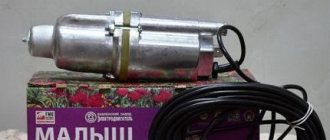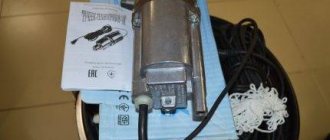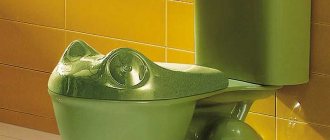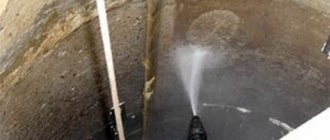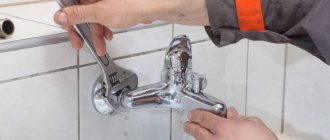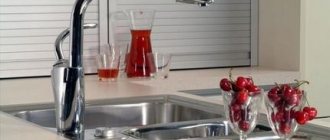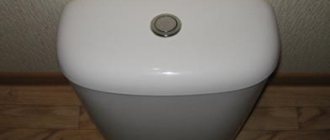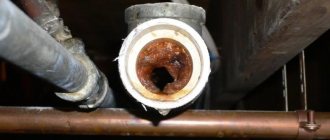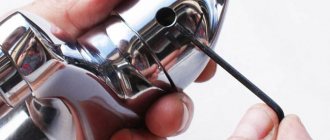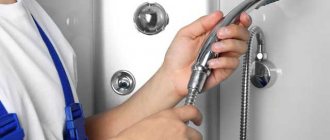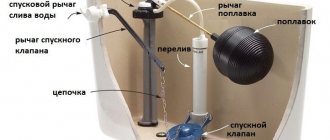Repair of fecal pumps
Using a fecal pump, you can pump wastewater containing large fragments. Like any equipment, it tends to break down; you need to know how to repair sewage pumps with your own hands, and be able to identify the causes of the breakdown.
How does a fecal pump work? When purchasing equipment, you should immediately examine the design elements without waiting for a breakdown. To do this, you should study the instructions for the device, which contains a diagram of the device and maintenance details.
The units used in the country, in a private house, have low power and a simple design. As a rule, they are compact and light in weight, on average from 3 to 7 kilograms. The parts are made of steel or plastic, and in rare cases cast iron.
Drainage device
The following are installed in the device body:
- Protective mesh on the bottom of the device. Prevents debris and large parts from getting into the impeller.
- Impeller (impeller). Rotating, it creates a rarefied environment around itself, due to which liquid is absorbed.
- Bearing shield. Protects the electric motor, rotor and shaft from moisture.
- The rotor sets the rotational energy for the impeller.
- The shaft is considered an element of the engine, passing through the entire cavity of the unit and attached to the rotor.
- The capacitor serves as a switch.
- Float. Located outside the device, when lowered it prevents the engine from starting, preventing overheating from dry running.
- Cable. Designed to supply electricity.
The design of the unit is sealed. In each compartment, including the engine, there are sealing rubber gaskets between the partitions.
How does a drain pump work?
This type of pumping equipment belongs to the “centrifugal” category. An impeller is mounted on the electric motor shaft, which pumps water. A large number of different models work on this principle. But the drainage one differs from the others in that its impeller is made of steel, while the walls of the blades are thicker than those of conventional devices. In addition, the passage between the unit body and the walls enclosing the feed chamber and the compartment where the electric motor is located is larger. This allows sand, small stones, organic inclusions and other large particles to move freely through the gap.
Manufacturers offer sump pumps with a float switch. The latter reacts to the level of pumped water. And if it drops to a critical level, the pump immediately turns off. The float serves as protection against dry running.
Common problems
Nature of the failure and cause of its occurrence:
- Doesn't buzz and doesn't work. The drainer is lowered into the water, the float has surfaced and is on the surface, the cable is connected to the circuit, but the engine does not work, there is no vibration. The cause of the breakdown is a discrepancy between the declared motor power and the electrical network to which the device is connected. Carefully read the characteristics of the pump, its power and efficiency. The pump is not lowered deep enough into the water and the float does not work. Remove the device and, lifting the pillow up, turn it back on.
- It works, but doesn't download . The engine is on, but no water comes to the surface. There are several reasons for this. The protective mesh blocking debris and stones at the bottom of the case is clogged. Raise the device and clean the filter. The thick fraction got into the discharge hose and a blockage occurred. If such a breakdown occurs, it may be knocked out of the base of the pump; if this does not happen, you need to disconnect it yourself and wash it. The impeller is broken. Its augers may break or the bearing may collapse; this can be found out by disassembling the pump.
- Vibrates and overheats. The electric motor braid was broken, water got into the engine compartment, and the shaft bearing was destroyed. The unit vibrates and heats up, while the water flows in jerks or stops altogether. We urgently turn off the power to the equipment and pull it to the surface. The cause of the breakdown is hidden inside. For diagnostics it is necessary to disassemble the case. Several impeller blades are broken. The rotation occurs with an eccentric and hits the body on one side.
- Low pressure with a properly running engine is a consequence of a breakdown of the mechanical part of the pump. Impeller or bearing, clogged discharge hose or suction filter. It can be eliminated by simply washing it in clean water or replacing mechanical parts.
- When the unit is connected to the network, the automatic switch is activated . The fuse cuts off the network if a short circuit occurs. Check all electronic parts of the pump. Go through the cable with a tester and find out where the short circuit occurred - replace it. The motor's copper braiding is also at risk if the unit is run dry. The braid can be replaced or a new engine installed only in a repair shop.
- The device works, but turns itself off. Connected to the network and working, pumping water properly. Suddenly it turns off on its own. The reason is a mismatch between the power of the motor and the electrical network. Voltage surges can also affect the smooth operation of the unit. The solution is simple - study the instructions and characteristics of the pump in detail, install a voltage stabilizer.
Tip: to pump out all the liquid completely, the float is tied to a cable in a vertical position and lowered into the water. Adjust the switching on and off of the device by unplugging the plug from the socket.
What to do if the pump hums but does not pump out?
In this case, most likely, the breakdown will be the unscrewing of the nuts around the shock absorbers or a worn out valve. You can solve these problems yourself. The pump will need to be disassembled and get to these same nuts. They need to be tightened, for this you can use your own wrench. If the nuts are rusty, it would be better to replace them completely so that they do not become “rooted” from rust.
You can also replace the valve yourself. Even if there is no severe damage to it, but only minor damage, it is recommended to replace it with a new one. To do this, you need to pick up in the store exactly the same valve as installed in your pump. You can do the replacement yourself by disassembling the entire pump and using special tools.
Causes of breakdowns
- Incorrect operation of the device. It is necessary to distinguish between drainage and fecal drainage, although at first glance they are similar. Using the former to pump out sewage is unacceptable. The device is used only for pumping conditionally clean water. Incorrect use often leads to damage to the unit. Constantly turning on and off at intervals of less than one minute has a detrimental effect on the motor and bearings.
- Cable damage. The power cable is one of the main elements of the pump. Without it, nothing will work. A break or break in the cord will result in the unit being de-energized. You can replace the cable yourself, the main thing is to choose the correct cross-section and number of cores. You cannot repair the cord only at the short circuit point. It is better to replace it completely, from the plug to the pump.
- Infrequent inspection and improper maintenance. Any device needs technical control. The drainage system is inspected for defects once every six months. If the unit is constantly in water, then it should be taken out once a quarter. During the inspection, procedures are carried out to lubricate the bearings and tighten the fixing bolts and nuts. Ignoring these steps will lead to breakdown of the main components of the device - repair of the drainage pump will be required.
- The unit runs dry. The pump must not operate without water. Only when immersed can it be connected to the network. The owners leave the units unattended, having pumped out all the water, the pump does not stop working, the engine overheats, and the braid of the engine compartment sticks together. A short circuit occurs - the device burns out completely, which leads to significant financial costs for expensive repairs.
- The device operating environment is incorrectly selected. There is an opinion that the drainer is suitable for pumping even liquids with a high content of silt and clay. Of course this is not true. In the first couple of hours, the motor will cope with the strained dense layer of sludge, but subsequently the movement of the thick fraction along the hose will create additional resistance to the motor. Eventually the unit will stop working. Small pebbles are detrimental to the impeller. The power of the device is enough to pull the pebbles into the impeller, but the rotation will stop once the stones get into the mixer augers.
- Incorrect installation of the unit. It must be placed in a container or reservoir, lowering the body with the float to a depth. It must be remembered that immersing the device and placing it on the bottom is unacceptable.
- Manufacturing defects. Nothing can be done about this phenomenon. There is only one piece of advice - do not throw away documents and the receipt for the purchased goods.
- Violation of the seal of the housing. When lowering the device to a depth or into a container for pumping out liquid, it is unacceptable to throw it or suddenly drown it. Hitting a rock or tank wall will cause cracks in the joints or the pump wall. Water will get inside and the engine will burn out or become unusable.
Differences between submersible and surface models
A submersible apparatus is useful for cleaning deep tanks, for example, a newly commissioned well. The first liquid accumulated in it cannot be called drinking, since there are many large inclusions of sand and clay. Throughout the day, it is necessary to pump out the contaminated liquid so that clean, usable water comes in its place.
The Gardena Classic drainage pump is designed for pumping dirty water, has a capacity of 6 thousand l/h with a maximum immersion depth of 7 m
Unlike a submersible pump, a surface pump is not used for deep tanks; it is more suitable for pumping water from a pool or basement when it is flooded. A hose is placed at the bottom of the container to receive dirty water, the second hose is used to drain wastewater.
If the pump is used in an emergency, it is appropriate to use a float device that will control the critical level of water rise. The advantage is that the design of the mechanism allows you to pump liquid with large pieces of dirt - up to 5 cm (less often - 10 cm).
It is clear that the surface type aggregate differs in its structure. The working shaft and wheel are fixed inside the metal casing, and the motor can be different: for centrifugal products - single-phase with external ventilation, for self-priming - asynchronous two-pole.
Despite the contamination of the pumping environment, you should not allow the pump to operate with liquid in which gasoline, kerosene or other petroleum products and chemicals are dissolved.
Maintenance Tips
After each use, remove the device from the water if the device is not in constant use.
Before immersing in liquid on the surface, plug in the unit and raise and lower the float several times. This way you can check the functionality of the pump.
When removing the device from the water, do not pull it by the cable or hose. For these purposes, a rope or cable is tied to the handle.
Pump out only relatively clean liquid (river water, groundwater, rain melt), without admixture of clay and silt.
Constantly clean the channels of the impeller protective box.
Composition of the pumping station
The pumping station is equipped with the following:
- Pumping unit. The main parameters for selecting a separate pump or a finished pumping installation are the required water flow (in cubic meters/hour) and pressure (in meters).
- Pressure accumulator. It is a metal tank in which water pressure is constantly maintained. As soon as water is withdrawn, the pressure in the tank drops and the pumps turn on. When the pressure in the tank reaches the maximum set value (water withdrawal stops, but the pump continues to work), the pumps are turned off.
- Automation block. It is difficult to imagine a modern pumping station without automation. It was the pump automation system that allowed us to reach a new level of comfortable existence.
Purpose of the pumping station
What are water supply installations used for? This is pumping water to the consumer from a water supply source (well, river, reservoir), and this requires a special pump booster device.
It is the pumping unit that takes water through suction pipelines and transfers it to a residential building or industrial building through pressure pipelines. No water supply system will work without pumping units.
Pumps are needed to supply water for drinking needs, to extinguish fires, pumping domestic and industrial wastewater, drainage of mines and basements, borehole and sand pumps. There are pumps for pumping solutions, feces, clean water, and petroleum products. The type and brand of pump is selected for each specific case.
Popular models: al ko (alco), grundfos, gardena 3000 4, grundfos, Gilex jumbo 60 35, marina, whirlwind, etc.
Types of water pumping stations
With built-in ejector
The principle of operation is based on the rise of water due to the created vacuum. The ascent is carried out from a depth of 20 - 45 meters. The pumping station has high productivity. Due to the high noise level, such a station should be located in the basement.
With remote ejector
A pump with this type of ejector is immersed in water with two pipes at once. Water entering the ejector causes a suction jet to appear. This type of pump is susceptible to sand blockages and corrosion.
Ejectorless designs
In these pumps, water is lifted using a multi-stage design. They operate silently and consume little electricity.
Malfunctions of pumping stations
These complex devices are quite reliable in operation. The first problems may arise 4-5 years after the start of operation, provided that no emergency situations occurred in which the pump had to rotate the impeller without water. And even then, these malfunctions rarely occur in the engine of the unit, but appear in other elements of the station:
- membrane hydraulic accumulator;
- pressure switch;
- check valve
The most common problem leading to complete failure of the pump motor is a malfunction of the check valve. It begins to let water through due to wear or clogging, the supply pipe is emptied, and the impeller rotates “dry”. The rubber “bulb” (membrane) installed in the accumulator tank may also lose its seal. There are also problems with the pressure switch, then the unit does not turn on when there is water supply in the house.
Do-it-yourself repair of the Vodomet submersible well pump
For a country house, the failure of a water pump means a daily trip with buckets to the well. The situation becomes more complicated if the water supply on the site is arranged around a well. Any person who is more or less familiar with technology can repair a “Rucheek” or “Malysh”, but the “Vodomet” submersible pump is not so easy to set up. The consequence of unqualified repairs may be contamination of the well with oil, which can only be eliminated by specialists.
If there is a service center nearby, of course, it is better to go there. But if this is not possible (the service center is far away, there is no time), you will have to repair the Vodomet pump yourself.
What does the pump consist of - let's look at the details
Vodomet borehole pumps, depending on the marking, have a different number of repeating stages. All internal parts can be divided into four types: impeller, glass, glass bottom and anti-friction washer. The first ones are made of white plastic. They are the same size, externally they resemble a mushroom - they have a stem and a cap.
The “glasses” are, of course, cylinders made of black polyamide. One of them has a belt resting on a white plastic ring. It is inserted oppositely closer to the motor in the pump housing. It is very difficult to take it out.
The bottom of the “glass” is a disk made of the same material. There is a hole in its center. They are inserted into the “glass” so as to form a double bottom.
Reassembly process
After the repair is completed, it is necessary to properly reassemble the pump. If you make mistakes at this stage, the device will need another repair.
When performing reverse assembly, you need to follow these steps:
- Reinstall the capacitor.
- Carefully lay the wires inside the motor housing.
- Press in the top pump cover.
- Insert the motor into the pump housing.
- Press in the assembled motor in such a way as to ensure its tight fit into the end of the housing.
- Insert the ring-shaped retaining gasket and push it until it stops using a suitable tool.
- Place the white impeller on the shaft with the smooth side facing the motor, i.e. down.
- Place the white gasket on the shaft, and then the assembled glass with the lid “bottom” (i.e. this lid) down.
- Put on the blue washer.
- Reinstall the impeller, white washer, glass, blue washer.
- Repeat until all elements are installed.
- Cover the stack of glasses with a lid and carefully tighten it using a gas wrench or other device.
To make it easier to press the motor into the housing during reassembly, the edge of the housing can be treated with silicone grease. During the installation process, you must pay attention to the numbering of the glasses and strictly follow the sequence of their installation. A pressure gasket is installed on top.
The working rings of the Vodomet pump wear out quickly, especially if they pump water heavily contaminated with sand. Replacing these elements is not difficult; it is important to properly disassemble and then assemble the pumping part of the device
In order to prevent further damage, it is recommended that in case of severe wear, replace this element with a new gasket. Typically, a new gasket can be purchased from the manufacturer or picked up at specialized retail outlets. After the pump repair is completed, you need to check its operation.
You can immerse it in a container of water, such as a bucket, to ensure that the device turns on and is able to pump water. But it is impossible to have an idea of how good the pressure the pump will provide in the system.
You can check the operation of the pump for pressure at a service center, but first it is better to check whether this is possible.
Another test option is possible if the pump owner has a large capacity container at his disposal. Of course, you can check the characteristics of a repaired pump directly in the well, but if problems are discovered during the test, the device will have to be removed from a fairly large depth. A preliminary check on the surface will help to avoid this.
